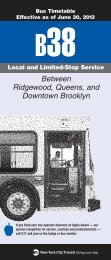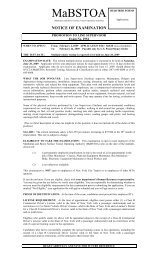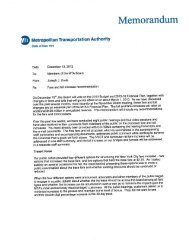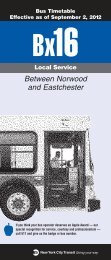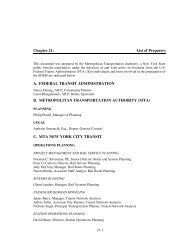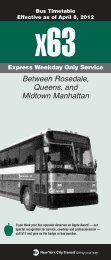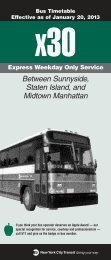Greening Mass Transit & Metro Regions: The Final Report - MTA
Greening Mass Transit & Metro Regions: The Final Report - MTA
Greening Mass Transit & Metro Regions: The Final Report - MTA
You also want an ePaper? Increase the reach of your titles
YUMPU automatically turns print PDFs into web optimized ePapers that Google loves.
Recommendation 3: Complete a Quantitative Vulnerability and Risk Assessment<br />
By 2012 at the latest, the <strong>MTA</strong> should have completed a thorough, quantitative vulnerability and risk assessment of the<br />
system’s climate hazards, including the assets, facilities, operations, and income streams of the <strong>MTA</strong> operating agencies,<br />
as well as its centralized insurance program. This assessment should include the climate vulnerability of the existing systems<br />
and of all new capital projects in their various stages of construction or design. <strong>The</strong> vulnerability and risk assessment<br />
should be both scenario-based for typical expected events but must also be performed probabilistically to allow estimates<br />
of annualized losses integrated over the range of climate-event magnitudes and probabilities and over the current and<br />
planned range of all <strong>MTA</strong> assets and operations. <strong>The</strong> assessments should be made for the current asset inventory and for<br />
the inventory and climate conditions as projected for the 2020s and 2050s. For major system elements most vulnerable<br />
to SLR and coastal storm surge flooding, such as tunnels, rail beds, and subways near or below sea level, additional risk<br />
assessments beyond the 2050s to the end of this century should be produced.<br />
Recommendation 4: Develop a Climate Change Adaptation Master Plan<br />
By 2015, the <strong>MTA</strong> should have completed a strategic climate change adaptation master plan detailing how the <strong>MTA</strong><br />
envisions the transformation of its transit system to cope with the progressive demands from climate change, including<br />
cost estimates. <strong>The</strong> master plan should take into account the results originating from Recommendations 2 and 3 (climate<br />
database and vulnerability risk assessments, respectively) as a basis for arriving at optimal adaptation measures along<br />
various decision paths and time horizons, projecting out at least 100 years. Though the specificity of this master plan will<br />
decrease the further out the projections, the <strong>MTA</strong> will need some basis for fundamental decisions on long-term capital<br />
projects. In particular, the <strong>MTA</strong> will have to make complex decisions on whether those transit systems that rely on tunnels<br />
and rails now at or below sea level can be made resilient in their existing locations, or whether they may require a fundamental<br />
redesign and more elevated siting. If elevations are feasible and necessary, they must be planned to account for the<br />
continuing reach of SLR and expanding flood zones. Part of such a strategic master plan will be to decide whether or not<br />
the New York and New Jersey harbor estuary should and can be protected by storm surge barriers, and whether such barriers<br />
might fail under the most extreme storm conditions and eventually become ineffective and unsustainable. It should be<br />
noted, that portions of <strong>MTA</strong> mass transit systems operating in Brooklyn, Queens, and Long Island and in Westchester<br />
and Connecticut would not be protected by the barriers as currently conceived.<br />
Recommendation 5: Establish a Pre-Disaster Plan for<br />
Potential Future Sea Level Rise<br />
Post-Disaster Redevelopment (PDP-PDR)<br />
<strong>The</strong> Battery, NYC<br />
By 2015, the <strong>MTA</strong> should establish a framework Pre-Disaster<br />
3 Ft<br />
80<br />
Plan for Post-Disaster Redevelopment (PDP-PDR), in concert<br />
with local, state, and federal governments and with input from<br />
60<br />
2 Ft communities and the public and private sectors. While an earlier<br />
40<br />
completion date is desirable for a PDP-PDR internal to the <strong>MTA</strong>,<br />
1 Ft such plans need to go far beyond the <strong>MTA</strong>’s principal mission to<br />
20<br />
provide efficient, safe, reliable, and affordable public transporta-<br />
0<br />
tion to the region. Apart from dealing with scientific, technical,<br />
2000 2020 2040 2060 2080 2100 and engineering issues, basic land use, urban design, economic<br />
Year<br />
and social issues are at stake. For this reason a PDP-PDR may<br />
have to be developed in conjunction with the regional adaptation<br />
master plan of Recommendation 4. Again, the opportunities<br />
Range of projected local sea level rise (SLR) for New York City as<br />
provided in conjunction with PlaNYC and other initiatives should<br />
optional input for precautionary planning purposes. <strong>The</strong> different<br />
lines represent projections for various atmospheric greenhouse gas be used as far as possible. <strong>The</strong> purpose of the PDP-PDR is to<br />
scenarios and climate models. <strong>The</strong> orange band depicts a range of transform a disaster into a one-time opportunity for collecting<br />
optional SLR planning scenarios during this century, implying 2ft<br />
information and realizing design and planning gains which are<br />
SLR as a minimum scenario, and 3 ft by the end of this century as<br />
precautionary target planning scenario.<br />
less achievable in advance through incremental steps. Without<br />
(Source: Modified from Jacob et al, 2007).<br />
such institutional preparedness, the learning opportunities an<br />
actual disaster provides can be easily squandered.<br />
Recommendation 6: Create an Adaptation Priority Task Force (APT)<br />
By mid-2009, the <strong>MTA</strong> should establish an Adaptation Priority Task Force (APT) that identifies unique opportunities for<br />
adaptation measures. Some current and ongoing projects may provide unique one-time opportunities for new construction<br />
during the operational maintenance cycle, or during the ongoing design and planning stages of capital projects to which<br />
the <strong>MTA</strong> is currently committed. Such critical opportunities to include adaptation measures to the extent still possible<br />
60<br />
Sea Level Rise (cm)



